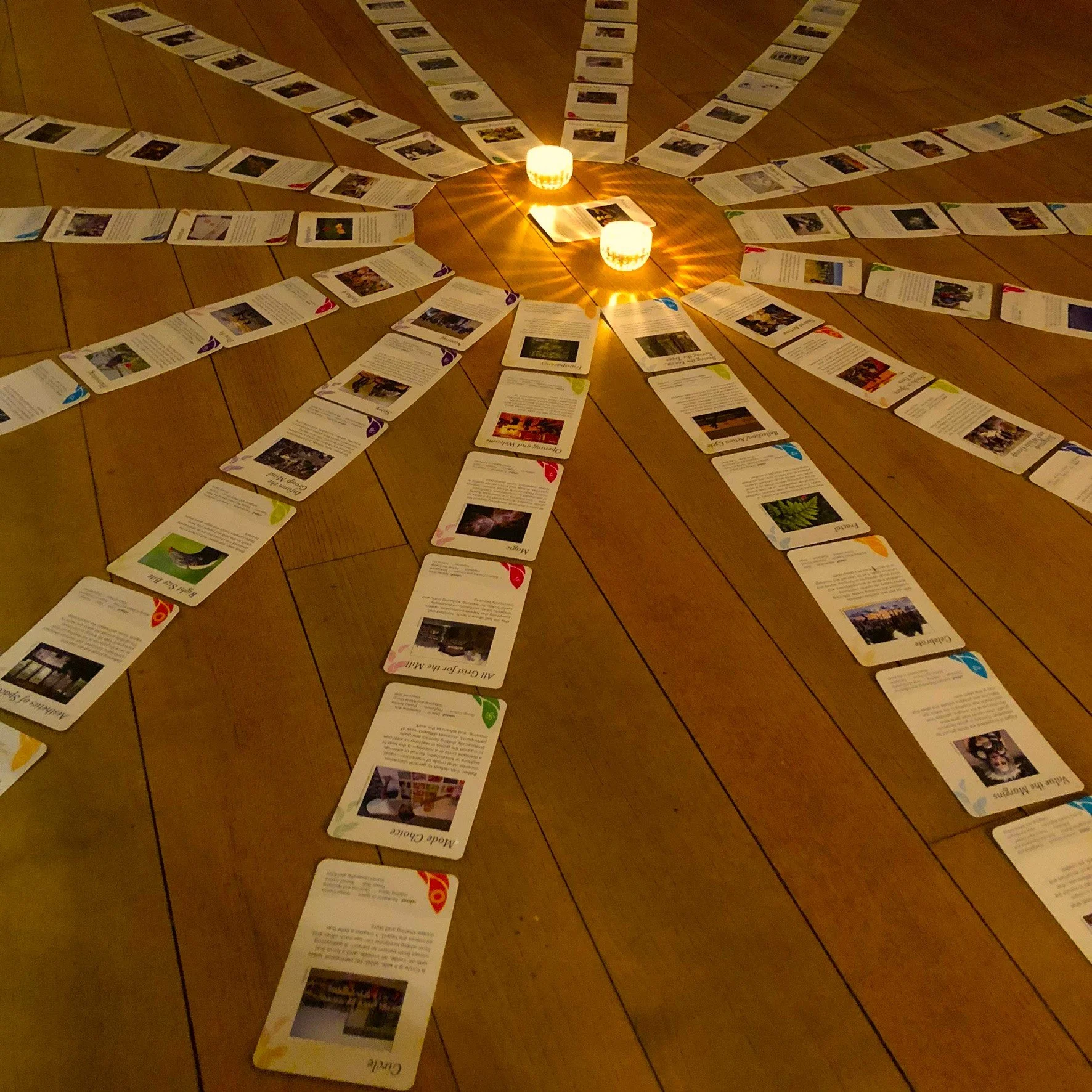I have used the Group Works Deck for a number of years to design many things. It is a Group Pattern Language Project that can be used in any way that your imagination can conjure up. Currently I am working on an event and the cards provide great brainstorming as well as layout ideas. The sky is the limit for finding ways to imagine with this deck. Get yourself a deck and start designing!
There are many ways to use the Group Works Deck to prepare for, plan and design a facilitated event. Probably the simplest is, with the design group, lay out all the cards by categories, collectively tell the 'story' of how you expect the event will transpire (e.g. from room setup and arrangements, advance research, invitations, welcoming, and opening through detailed agenda, anticipated challenges and closing). As you do, work through the cards, category by category, to identify the ones you could effectively invoke during each stage of the event. Take notes of how, when and by whom each pattern will be invoked, as you begin to lay out the event design. When you're done, glance over the patterns you haven't chosen to see whether any opportunities jump out for you.
Crafting Collaboration: A Comprehensive Guide to Designing an Event with the Group Works Deck
Introduction:
In a world that thrives on effective communication and collaboration, designing events that foster meaningful interactions is essential. One powerful tool that can elevate your event planning process is the Group Works Deck. This deck, comprised of 91 cards categorically organized into seven suits, offers a versatile framework for designing and facilitating group dynamics. In this blog post, we'll explore how to leverage the Group Works Deck to craft an engaging and successful event.
Understanding the Group Works Deck:
The Group Works Deck is a treasure trove of patterns, each card representing a fundamental aspect of group processes. The seven suits include Opening, Clarifying, Building, Achieving, Reflecting, Closing, and Heart. Here's a breakdown of each suit's significance:
Opening: Setting the Stage
Use cards from this suit to establish a positive and inclusive atmosphere.
"Welcome and Inclusion" and "Setting the Container" cards are perfect for initiating connections.
Clarifying: Defining Intentions
Cards like "Purpose," "Aims and Objectives," and "Agendas" guide participants in aligning their goals and understanding the event's purpose.
Building: Fostering Creativity
Encourage creativity and collaboration through cards like "Diversity," "Play," and "Storytelling."
These cards can inspire innovative thinking and open communication channels.
Achieving: Making Progress
Measure success and progress using cards like "Harvest" and "Evaluation."
Ensure that your event's goals are met and celebrate achievements along the way.
Reflecting: Learning and Adapting
Foster introspection and improvement with cards like "Feedback Loops" and "Learning Edge."
Create opportunities for participants to reflect on their experiences and share insights.
Closing: Bringing it All Together
Use cards from this suit to facilitate a thoughtful conclusion.
"Check-Outs" and "Harvest" cards help participants express their feelings and thoughts about the event.
Heart: Embracing the Emotional Connection
Central to any gathering, cards like "Appreciation" and "Celebration" foster a sense of community and gratitude.
Practical Application:
Card Selection:
Tailor your event by selecting cards that align with its theme and objectives.
Arrange the chosen cards visibly for participants to reference throughout the event.
Facilitation:
Use the Group Works Deck as a guide to structure your event, maintaining a balance between opening, creative, and reflective activities.
Incorporate interactive sessions inspired by specific cards, encouraging participant engagement.
Interactive Sessions:
Integrate interactive sessions that align with the chosen patterns, such as group discussions or creative exercises.
Keep the atmosphere dynamic and engaging to enhance collaboration.
Feedback and Reflection:
Leverage cards from the Reflecting suit to gather participant feedback.
Foster a culture of continuous improvement for future events by learning from each experience.
Conclusion:
Designing an event using the Group Works Deck adds a layer of intentionality and structure that can transform your gathering into a collaborative and enriching experience. By incorporating these cards into your planning and facilitation process, you create a roadmap for effective group dynamics, ensuring that your event leaves a lasting impact on participants and facilitates connections that extend beyond the occasion. So, embrace the power of the Group Works Deck and craft events that inspire collaboration, creativity, and meaningful connections.
